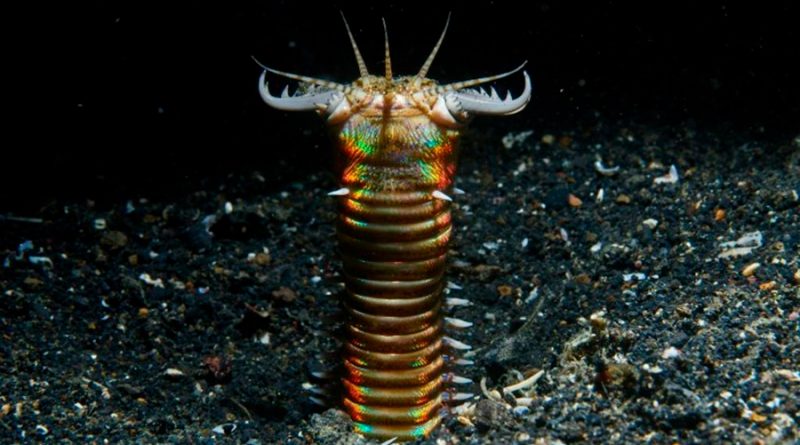The depths of the ocean continue to harbor amazing animal life creatures hitherto unknown to science. An exploration under the seabed at the hydrothermal vents of the Eastern Pacific Ridge has revealed complex habitats in the depths, where worms and gigantic bivalves live.
The Eastern Pacific Ridgewhich is volcanically active and located at the intersection of two tectonic plates, contains numerous hydrothermal vents. These openings in the seabed are where seawater and magma meet beneath the Earth’s crust.
A team of scientists has oceanographic exploration in which they discovered animal life beneath the seabed in these vents, according to a study published in the journal Nature communication.
“Hydrothermal vents are very special because they are oasis of life in the middle of the desert from the deep ocean floor. Since its discovery in the 1970s, it has fascinated us with its colorful atmosphere white tube worms with feathers like crimson lips or with gigantic yellow mussels and enormous white mussels“, die Salvador Espada Hinojosascientist at the University of Vienna (Austria), co-author of the study and member of the oceanographic campaign.
Aboard the Schmidt Ocean Institute’s Falkor research vessel, they began a series of dives into one of these hydrothermal vents located 2,515 meters deep on the East Pacific Ridge using the SuB-Asian remote-controlled vehicle.
“We flew over these places with submarines or remotely operated probes and discovered that this striking life also extends downwards, that is, in the lower part of the basalt created by the volcanic eruptions that formed the bottom of the ocean and generate the planet,” says the scientist.
A remote, hard-to-reach journey to discover tube worms and giant yellow mussels
Previous research had focused on the organisms that live on the seafloor around these vents, including tube worms and musselsbut the possibility that animal life existed beneath the shallow crust of the seafloor has remained largely unexplored.
“At a depth of two and a half kilometers you have the weight of all that water on top of you, so the pressure literally crushes you at 250 atmospheres. The area we studied is very remote, thousands of kilometers from the nearest coast. You must have everything prepared and have spare parts for any incident because there is no way to improvise solutions as soon as you encounter a problem. You have what you wear,” Espada emphasizes.
By uncovering parts of the seafloor crust using the rover’s arms, the team discovered warm, fluid-filled cavities inhabited by several species previously found only on the seafloor. Among them were found giant tube worms and mobile animals such as worms and snails.
The authors suggest that larvae from ocean floor communities may settle in these subsurface habitats, indicating: complex connectivity between both ecosystems.
Espada says it has been an investigation “with quite a few difficulties. The ship is in motion and exposed to the weather. Furthermore, in the laboratory we do very delicate techniques and when the weather is bad we have to secure the instruments so that they do not fall. Many of the techniques must be performed very quickly with fresh biological material, so everything must be prepared in advance. If the submarine rises with the material, you have to get to work quickly.”
Life full of colors finds its way in inhospitable conditions
Hydrothermal vents are hot areas in the middle of a deep ocean that are so cold that, without the enormous pressure the water is under, it would freeze.
“Through the cracks of the planet, heat and fluids from the Earth’s interior escape, mixing with the cold seawater and creating areas where life colonizes and flourishes thanks to chemosynthesis – the ability to create living matter without the help of the Earth Sun -, which uses the energy of chemical compounds that come from the interior of the Earth, such as sulphur,” explains the co-author.
Until now, previous research had provided knowledge about microbial life under the bark, but no animal life had yet been found.
“The temperatures and chemical conditions Because the acidity of these cavities that penetrate deep into the Earth’s crust is very extreme, we are always surprised by the ability of microbes to push life to the limits of its capabilities. The fact that there are also animals that colonize the most superficial areas of this underground world broadens our vision of these ecosystems,” said the researcher.
This whole life has great complexity. Giant tube worms, as well as mussels and clams from hydrothermal vents, live together with bacteria that create living matter without the need for the sun, using chemosynthesis instead of photosynthesis.
Likewise, these tube worms do not have a digestive system, mouth or anus, but instead have a special organ in which they house these symbiotic bacteria. They are giants because in these conditions of abundance they grow very quickly and reach a length of two meters.
“The mussels and clams are also quite large, about 80 centimeters in fact, much larger than the species we are used to seeing in coastal waters, or that we eat,” Espada Hinojosa points out.
Challenges for the discovery of animal habitats in the subsurface of the Earth’s crust
For researchers, the discovery of animal habitats in the subsurface of the earth’s crustthe extent of which is currently unknown, increases the urgency of taking protective measures against possible future environmental changes.
“It would be interesting to find ways to drill into the basalt and sample deeper to see the extent of this ecosystem. The question also arises when the larvae travel below the surface of the ocean floor, how the different animal populations are connected, whether there are clear migrations and whether these are determined by the physical or whether they occur randomly,” the scientist concludes. .
Reference:
Monika Bright et al. “Animal life in the shallow subseafloor crust at deep-sea hydrothermal vents,” Nature communication.

